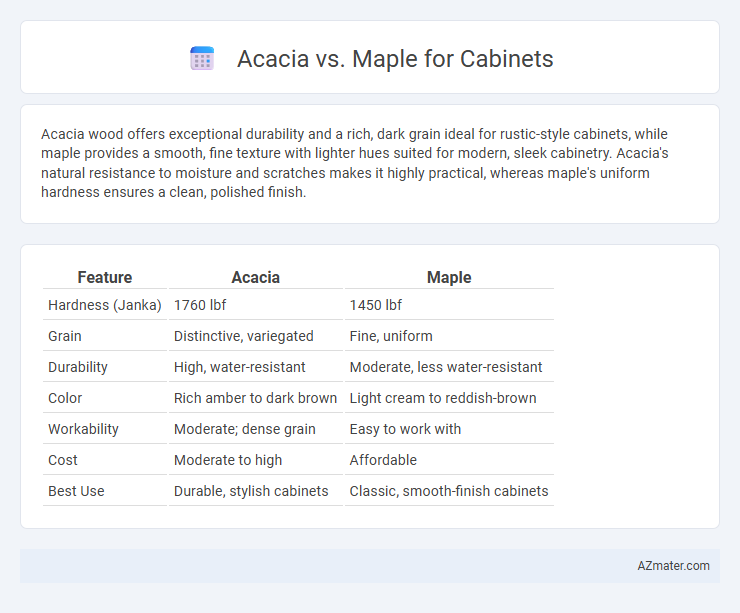Acacia wood offers exceptional durability and a rich, dark grain ideal for rustic-style cabinets, while maple provides a smooth, fine texture with lighter hues suited for modern, sleek cabinetry. Acacia's natural resistance to moisture and scratches makes it highly practical, whereas maple's uniform hardness ensures a clean, polished finish.
Table of Comparison
| Feature | Acacia | Maple |
|---|---|---|
| Hardness (Janka) | 1760 lbf | 1450 lbf |
| Grain | Distinctive, variegated | Fine, uniform |
| Durability | High, water-resistant | Moderate, less water-resistant |
| Color | Rich amber to dark brown | Light cream to reddish-brown |
| Workability | Moderate; dense grain | Easy to work with |
| Cost | Moderate to high | Affordable |
| Best Use | Durable, stylish cabinets | Classic, smooth-finish cabinets |
Introduction to Acacia and Maple Cabinets
Acacia cabinets are prized for their rich, varied grain patterns and natural durability derived from hardwood species native to Australia and Southeast Asia, making them resistant to scratches and moisture. Maple cabinets, sourced from dense North American hardwood trees, feature a smooth, fine grain and light color that lends itself well to staining and painting, providing a versatile and modern finish. Both acacia and maple woods offer distinct aesthetic and functional benefits, with acacia delivering exotic warmth and robustness, while maple ensures uniformity and strength suitable for diverse kitchen designs.
Wood Characteristics: Acacia vs Maple
Acacia wood features a rich, dark grain with high natural oils that enhance durability and resistance to moisture, making it ideal for kitchens prone to humidity. Maple offers a light, smooth grain with a uniform texture that is dense and hard, providing excellent resistance to scratches and dents. Both woods are strong and suitable for cabinets, but Acacia emphasizes moisture resistance while Maple prioritizes surface hardness and a clean aesthetic.
Durability and Hardness Comparison
Acacia wood exhibits superior hardness with a Janka rating of around 1,070, offering exceptional durability and resistance to dents for cabinet construction. Maple, particularly hard maple, scores higher at approximately 1,450 on the Janka hardness scale, making it denser and more resistant to wear over time. While both woods provide strong performance, maple's increased hardness ensures longer-lasting cabinets in high-traffic environments, whereas acacia combines durability with unique grain patterns for aesthetic appeal.
Aesthetic Differences: Grain and Color
Acacia wood showcases a rich, varied grain with swirling patterns and deep amber to reddish-brown hues, adding warmth and a natural, rustic charm to cabinets. Maple features a smoother, more uniform grain with lighter shades ranging from creamy white to pale golden, offering a clean, contemporary aesthetic. Choosing between Acacia and Maple depends on whether the desired cabinet look favors bold, textured character or subtle, sleek simplicity.
Cost Analysis: Acacia vs Maple Cabinets
Acacia cabinets generally cost more than maple cabinets due to the hardwood's durability and rich grain patterns, with prices ranging from $150 to $300 per linear foot compared to maple's $100 to $250 per linear foot. Maple cabinets offer a cost-effective solution while still providing a smooth finish and strength suitable for kitchen use. Considering long-term investment, Acacia's resistance to dents and scratches can reduce maintenance expenses, making it a viable option despite the higher initial cost.
Maintenance and Care Requirements
Acacia cabinets require regular sealing and occasional oiling to maintain their rich, natural finish and prevent moisture damage. Maple cabinets are easier to care for, needing only mild cleaning with non-abrasive products and occasional polishing to preserve their smooth, light appearance. Both woods benefit from avoiding excessive moisture and direct sunlight, but Acacia demands more frequent maintenance to sustain its durability and vibrant grain patterns.
Environmental Impact and Sustainability
Acacia wood, sourced from fast-growing and drought-resistant trees, offers higher sustainability due to its rapid renewal compared to slower-growing maple. Maple harvesting often leads to increased deforestation and habitat disruption, impacting biodiversity more significantly. Choosing Acacia for cabinets supports environmental conservation by utilizing a more renewable resource with a lower carbon footprint.
Cabinet Style Compatibility
Acacia wood offers a rich, warm grain pattern that complements rustic, farmhouse, and traditional cabinet styles, enhancing their natural, earthy appeal. Maple features a smooth, consistent grain with lighter tones, making it ideal for modern, contemporary, and shaker-style cabinets where clean lines and minimalistic design are emphasized. Both woods provide durability, but Acacia's distinct texture and color variation create a more visually striking cabinet, whereas Maple's uniformity supports sleek and versatile cabinetry aesthetics.
Pros and Cons of Acacia Cabinets
Acacia cabinets are prized for their durability, unique grain patterns, and rich color variations, making them a standout choice in kitchen design compared to maple. They resist scratches and dents better than maple, offering long-lasting performance in high-traffic areas. However, Acacia's natural oil content can make it more challenging to stain evenly, and its higher cost may be a consideration for budget-conscious projects.
Pros and Cons of Maple Cabinets
Maple cabinets offer a smooth, fine grain that enhances durability and provides a clean, classic look favored in modern kitchens. Their hardness makes them resistant to dents and scratches, ensuring longevity and minimal maintenance. However, maple wood can be prone to color blotching when stained unevenly, requiring careful finishing to maintain a consistent appearance.

Infographic: Acacia vs Maple for Cabinet
 azmater.com
azmater.com